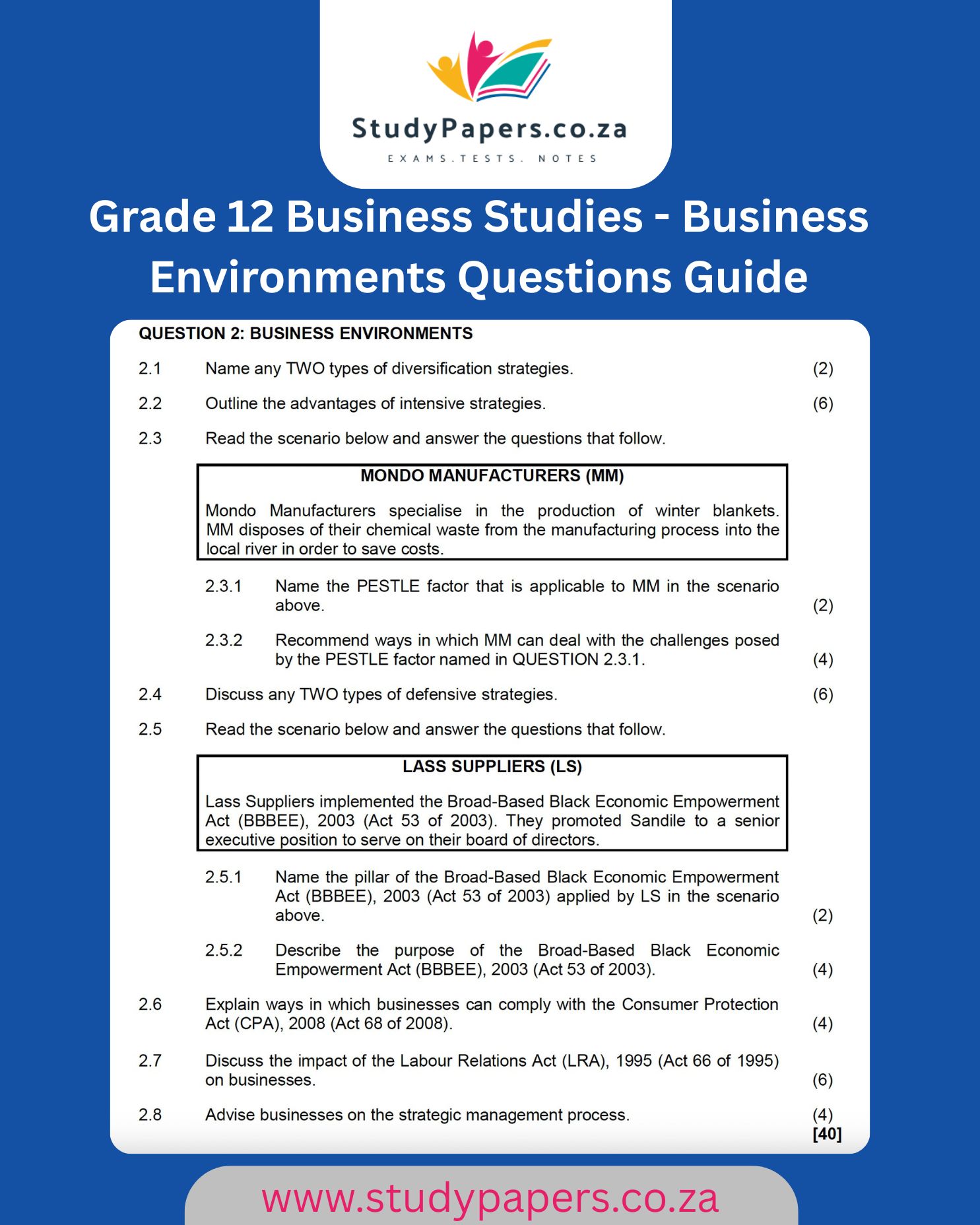Success in Grade 12 Business Studies – Business Environments topic depends on a strong understanding of business legislation and strategies. Many students struggle with integration, diversification, defensive strategies, and the correct application of Acts like the CPA, NCA, LRA, and EEA, which leads to lost marks.
This StudyPapers.co.za guide will help you as a 2025 Grade 12 Business Studies student to avoid common mistakes that students make when answering business environments questions in the exams.
This guide is based on Grade 12 Business Studies 2024 exam questions.
Guide for South African Students on Answering Grade 12 Business Studies – Business Environments Questions

1. Understanding the Question Structure
The Grade 12 Business Studies – Business Environments section often assesses business legislation and strategies, topics which historically pose challenges for students. To answer effectively:
- Identify the specific strategy or legislation being assessed.
- Use clear, precise terms from the 2021 Examination Guidelines.
- Ensure responses directly address what is asked.
2. Common Mistakes & How to Avoid Them
Here is how students can correct the errors commonly made in previous exams:
| Mistake | How to Correct It |
|---|---|
| Confusing integration and diversification strategies (Q2.1) | Ensure answers focus only on diversification strategies. Use the strategy types listed in the guidelines. |
| Writing advantages of diversification instead of intensive strategies (Q2.2) | First, understand the three types of intensive strategies before explaining their advantages. |
| Incorrectly answering challenges posed by PESTLE’s environmental factor (Q2.3.2) | List specific challenges and provide direct solutions for each, rather than vague or irrelevant responses. |
| Using “divestment” instead of “divestiture” (Q2.4) | Avoid divestment—this term is not awarded marks. Stick to the term “divestiture”. |
| Confusing liquidity with liquidation (Q2.4) | Liquidity = ability to pay short-term debts. Liquidation = selling all assets to pay creditors. |
| Incorrectly naming BBBEE pillars or misunderstanding its purpose (Q2.5) | Know only the official pillars from the 2021 guidelines—others won’t receive marks. |
| Confusing CPA (Consumer Protection Act) with NCA (National Credit Act) (Q2.6) | Clearly distinguish the purpose, impact, and compliance of CPA and NCA. |
| Mixing LRA with EEA (Labour Relations Act vs Employment Equity Act) (Q2.7) | Avoid discussing discrimination under LRA—this applies to EEA. Focus on fair labour practices. |
| Confusing strategy evaluation with the strategic management process (Q2.8) | When asked about strategy evaluation, focus only on the last step—checking success. |
3. Answering Techniques for Better Marks
Here’s what students can do to improve their responses:
- Use tables to link PESTLE factors with solutions.
- Be precise—avoid unnecessary details or mixing concepts.
- Stick to the terminology used in DBE notes and marking guidelines.
- When discussing defensive strategies, follow the correct sequence:
- Retrenchment (cost reduction through staff cuts)
- Divestiture (selling parts of the business)
- Liquidation (closing down & selling assets)
- When discussing legislation, highlight the purpose and impact before explaining compliance.
4. Final Exam Tips
- Use keywords and avoid unrelated explanations.
- Always check past Diagnostic Reports for known errors.
- If asked about laws, explain compliance, not just the purpose.
- When defining business strategies, know the four categories:
- Integration strategies
- Intensive strategies
- Diversification strategies
- Defensive strategies
We have a large collection of past papers for Business Studies Grade 12 Here
